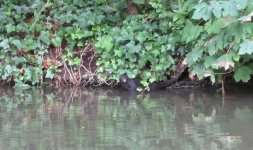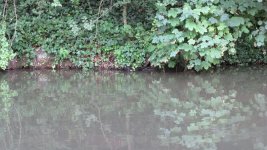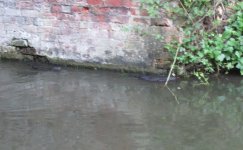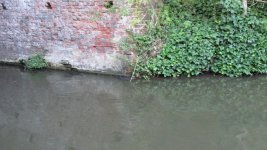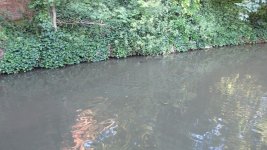-
Welcome to BirdForum, the internet's largest birding community with thousands of members from all over the world. The forums are dedicated to wild birds, birding, binoculars and equipment and all that goes with it.
Please register for an account to take part in the discussions in the forum, post your pictures in the gallery and more.
You are using an out of date browser. It may not display this or other websites correctly.
You should upgrade or use an alternative browser.
You should upgrade or use an alternative browser.
Coney Meadow and Adjoining Areas (6 Viewers)
- Thread starter Woodchat
- Start date
More options
Who Replied?Mary
Well-known member
Hi Mary,
Although the Glow-worm habitat isn't directly threatened at present, I am concerned that nearby housing developments (currently being built) could have adverse long-term effects on the future of this colony. When the developments are completed, there will undoubtedly be greater levels of artificial illumination as well as increased human disturbance (and antisocial activities) in the area. Just this Saturday afternoon there was an incident that I had to report to the police - a group of youths were riding motorbikes around Gorsey Bank - which, apart from anything else, presented a potential hazard to anyone walking in the area. They left a load of rubbish / beer cans in their wake. Sadly, I can't see this kind of thing reducing in frequency when 1000+ more people take up residence nearby.
I can only hope that the colony starts to spread to areas on the other side of the canal where it is generally quieter.[/QUOTE
Sounds like it's another all too frequent situation. :-C
Would the Canal Trust, assisted perhaps by Worcs WT, consider relocating some of them before it's too late?
Triturus
Triturus
Hi Mary,
Although the Glow-worm habitat isn't directly threatened at present, I am concerned that nearby housing developments (currently being built) could have adverse long-term effects on the future of this colony. When the developments are completed, there will undoubtedly be greater levels of artificial illumination as well as increased human disturbance (and antisocial activities) in the area. Just this Saturday afternoon there was an incident that I had to report to the police - a group of youths were riding motorbikes around Gorsey Bank - which, apart from anything else, presented a potential hazard to anyone walking in the area. They left a load of rubbish / beer cans in their wake. Sadly, I can't see this kind of thing reducing in frequency when 1000+ more people take up residence nearby.
I can only hope that the colony starts to spread to areas on the other side of the canal where it is generally quieter.[/QUOTE
Sounds like it's another all too frequent situation. :-C
Would the Canal Trust, assisted perhaps by Worcs WT, consider relocating some of them before it's too late?
Interesting point, I highlighted this in my objection letter to the Chawson Lane development. As follows:
Invertebrates - No appraisal of the potential invertebrate assemblage of the area has been undertaken and as such no assessment of impacts has been made. It is documented publicly that a colony of glow worms (Lampyris noctiluca), are present in the entrance area to Droitwich community woods a currently un-illuminated area close to the site entrance. Glow worms are limited in their distribution in the county and are reported to be in decline. The effect of artificial lighting on glow worm populations is not clearly understood but there is evidence that males are attracted to artificial lighting and therefore may become less efficient at detecting females. Females may not begin to glow if the background light levels are too high as they would consider it to still be ‘daylight’, or may decrease the amount of time they spend glowing and therefore decrease their chance of attracting a mate. These scenarios could decrease the population size due to decreased mating success/opportunities or make areas of otherwise suitable habitat unsuitable. No consideration has been given to invertebrates and impacts upon them.
The reality is that glowworms have no special status other than they are a bit more charismatic than a genuinely rare midge.
The key will be to get a number of sites in the locality in suitable condition and to manage them. My gut feel is that there are various areas that are suitable locally, maybe they are under recorded? or the population is just very localised.
As for translocation very little has been done on this in the past, however I was involved in a scheme in Buckinghamshire which is being monitored this year so watch this space for results. Females are easy to catch, they glow and they don't fly away, males however do not glow but the do fly. To ensure we caught males and females we cobbled together some green LED lights with some watch batteries (all from Maplins) to act as alluring females in a funnel trap (to the untrained eye this looks like a lemonade bottle), and yes, the male glowworm, when he is in the mood for love really does fall for this cunning plan.
We shall have an article on this in the next Chartered Institute of Ecology and Environmental Management magazine so i'll see if I can post a copy here. Until this is published the is no definitive guide on this process.
Triturus
Mary
Well-known member
Interesting point, I highlighted this in my objection letter to the Chawson Lane development. As follows:
Invertebrates - No appraisal of the potential invertebrate assemblage of the area has been undertaken and as such no assessment of impacts has been made. It is documented publicly that a colony of glow worms (Lampyris noctiluca), are present in the entrance area to Droitwich community woods a currently un-illuminated area close to the site entrance. Glow worms are limited in their distribution in the county and are reported to be in decline. The effect of artificial lighting on glow worm populations is not clearly understood but there is evidence that males are attracted to artificial lighting and therefore may become less efficient at detecting females. Females may not begin to glow if the background light levels are too high as they would consider it to still be ‘daylight’, or may decrease the amount of time they spend glowing and therefore decrease their chance of attracting a mate. These scenarios could decrease the population size due to decreased mating success/opportunities or make areas of otherwise suitable habitat unsuitable. No consideration has been given to invertebrates and impacts upon them.
The reality is that glowworms have no special status other than they are a bit more charismatic than a genuinely rare midge.
The key will be to get a number of sites in the locality in suitable condition and to manage them. My gut feel is that there are various areas that are suitable locally, maybe they are under recorded? or the population is just very localised.
As for translocation very little has been done on this in the past, however I was involved in a scheme in Buckinghamshire which is being monitored this year so watch this space for results. Females are easy to catch, they glow and they don't fly away, males however do not glow but the do fly. To ensure we caught males and females we cobbled together some green LED lights with some watch batteries (all from Maplins) to act as alluring females in a funnel trap (to the untrained eye this looks like a lemonade bottle), and yes, the male glowworm, when he is in the mood for love really does fall for this cunning plan.
We shall have an article on this in the next Chartered Institute of Ecology and Environmental Management magazine so i'll see if I can post a copy here. Until this is published the is no definitive guide on this process.
Triturus
Many thanks for your reply, Triturus. Fascinating work! Would love to read the outcome when available.
It's the old story that the Tigers and Pandas etc, whilst very much in need of help, get all the headlines and the humble insects just get squashed. I say that because when we were outside Morrisons in Stratford yesterday, there was a trodden-on Hawk-moth on the path, too flat to id, but the colours of Poplar maybe. Education, education, education - from nursery school age.
Phil Andrews
It's only Rock and Roller but I like it

A Whimbrel just flew due west over Coney Meadow - calling.
Patch tick Dave?
Woodchat
Cogito ergo sum
Patch tick Dave?
Second patch record - I had two together in spring a few years ago.
Woodchat
Cogito ergo sum
Apart from the Whimbrel, a relatively quiet weekend birdwise:
Little Owl Ladywood, 2 Ravens, Buzzards, Sedge Warblers (2 adults and 2+ juvs), Lesser Whitethroat, Reed Warblers, Common Whitethroats, Blackcaps, Chiffchaffs, 2+ Nuthatches around Porter's Mill (unusual there) and more in other places, Treecreepers, Goldcrests, Green and Great Spot Woodpeckers, 10+ Mistle Thrushes, Grey Herons, Linnets, Reed Buntings, Stock Doves, Goldfinches, Swallows, House Martins, Sand Martins, Swifts, Skylarks, Pheasant, Coal Tit and Pied Wagtails.
Little Owl Ladywood, 2 Ravens, Buzzards, Sedge Warblers (2 adults and 2+ juvs), Lesser Whitethroat, Reed Warblers, Common Whitethroats, Blackcaps, Chiffchaffs, 2+ Nuthatches around Porter's Mill (unusual there) and more in other places, Treecreepers, Goldcrests, Green and Great Spot Woodpeckers, 10+ Mistle Thrushes, Grey Herons, Linnets, Reed Buntings, Stock Doves, Goldfinches, Swallows, House Martins, Sand Martins, Swifts, Skylarks, Pheasant, Coal Tit and Pied Wagtails.
Last edited:
Birder Gladys
Well-known member
sorry to the bearer of bad news but had 2 Mink yesterday by the overflow outlet just by the bridge at Salwarpe.
Attachments
Triturus
Triturus
sorry to the bearer of bad news but had 2 Mink yesterday by the overflow outlet just by the bridge at Salwarpe.
that enough for a pair of gloves! 3
Woodchat
Cogito ergo sum
Report from patch over the weekend:
Little Owl at Ladywood.
Hobby at Porter's Mill.
Singing Yellowhammer at Porter's Mill plus 2 Canada Geese.
Grey Herons, 2 Ravens, juvenile Reed Warblers and Sedge Warblers, Reed Buntings, Coal Tits, Goldcrests, Nuthatches, Treecreeper, Buzzards, Kestrel, Sparrowhawk, Swifts, House Martins, swallows, Blackcaps, Chiffchaffs, Common Whitethroats, Green Woodpeckers, Linnets, Bullfinch and Long-tailed Tits.
Butterflies included 6+ Common Blues, 5 Brimstones, Large Whites, 1 Small Copper, Commas, Speckled Woods, Red Admirals, Gatekeepers, Essex Skippers and Peacocks. I'm pretty sure I had a Brown Argus too but it was too brief and flighty to be 100% (would be a patch first).
Also saw a couple of the distinctive blue-green leafhoppers Cicadella viridis in Coney Meadow. Lots of Grasshoppers and Bush Crickets at the moment.
Dragonflies included Souther Hawker, Brown Hawkers, Emperor and Common Darters.
I counted at least 41 Glow-worms last night - a new record single count with a lot of new ones.
Little Owl at Ladywood.
Hobby at Porter's Mill.
Singing Yellowhammer at Porter's Mill plus 2 Canada Geese.
Grey Herons, 2 Ravens, juvenile Reed Warblers and Sedge Warblers, Reed Buntings, Coal Tits, Goldcrests, Nuthatches, Treecreeper, Buzzards, Kestrel, Sparrowhawk, Swifts, House Martins, swallows, Blackcaps, Chiffchaffs, Common Whitethroats, Green Woodpeckers, Linnets, Bullfinch and Long-tailed Tits.
Butterflies included 6+ Common Blues, 5 Brimstones, Large Whites, 1 Small Copper, Commas, Speckled Woods, Red Admirals, Gatekeepers, Essex Skippers and Peacocks. I'm pretty sure I had a Brown Argus too but it was too brief and flighty to be 100% (would be a patch first).
Also saw a couple of the distinctive blue-green leafhoppers Cicadella viridis in Coney Meadow. Lots of Grasshoppers and Bush Crickets at the moment.
Dragonflies included Souther Hawker, Brown Hawkers, Emperor and Common Darters.
I counted at least 41 Glow-worms last night - a new record single count with a lot of new ones.
Woodchat
Cogito ergo sum
A bright and immaculate-looking Willow Warbler (sub-singing) was the highlight of this morning's early stroll - which tells you how slow any kind of migration on the patch is at the moment! Plenty of other Warbler activity - especially Chiffchaffs. Pretty quiet otherwise with only 'resident' birds apparent (as opposed to passage). Recorded this week include: Grey Wagtail, Cormorant, Canada Geese, Blackcaps, Whitethroats, Sedge Warblers, Reed Warblers, Linnets, Coal Tits, Goldcrests, Grey Heron, juvenile Green Woodpeckers, Bullfinch, Ravens, Buzzards, Sparrowhawk, Swallows and House Martins. Fewer Swifts around.
Mary
Well-known member
Just had my best ever single count of Mistle Thrushes on the patch - at least 59 in a single loose flock!
Strewth! I didn't know there were that many in the county! Were they on the move, do you think?
Woodchat
Cogito ergo sum
Strewth! I didn't know there were that many in the county! Were they on the move, do you think?
Post-breeding gathering I'd guess - the flew directly over Coney in waves of 10 -20 over the course of a couple of minutes. Further birds were around Porter's Mill this morning.
Woodchat
Cogito ergo sum
Highlights from the weekend:
Little Owl Ladywood
Tawny Owl Salwarpe
Lesser Whitethroat porter's Mill
Yellowhammer (singing) Porter's Mill
Grey Wagtails, 2 Cormorants, Canada Geese, Common Whitethroats, Buzzards, Kestrels, Sparrowhawks, Pied Wagtails, Goldcrests, Nuthatches, Coal Tits, Mistle Thrushes, Grey Herons, Blackcaps, Chiffchaffs, Reed + Sedges, Greenfinches, linnets, Goldfinches, House Martins and still a few Swifts.
200+ Swallows roosted last night plus a few Sand Martins.
Insects included 8+ Common Blues, Small Copper, Speckled Woods, Meadow Browns, Essex Skippers and Gatekeepers plus Brown Hawkers, Southern Hawkers, Banded Demoiselles and Common Darters.
16 Glow-worms counted last night.
Little Owl Ladywood
Tawny Owl Salwarpe
Lesser Whitethroat porter's Mill
Yellowhammer (singing) Porter's Mill
Grey Wagtails, 2 Cormorants, Canada Geese, Common Whitethroats, Buzzards, Kestrels, Sparrowhawks, Pied Wagtails, Goldcrests, Nuthatches, Coal Tits, Mistle Thrushes, Grey Herons, Blackcaps, Chiffchaffs, Reed + Sedges, Greenfinches, linnets, Goldfinches, House Martins and still a few Swifts.
200+ Swallows roosted last night plus a few Sand Martins.
Insects included 8+ Common Blues, Small Copper, Speckled Woods, Meadow Browns, Essex Skippers and Gatekeepers plus Brown Hawkers, Southern Hawkers, Banded Demoiselles and Common Darters.
16 Glow-worms counted last night.
Users who are viewing this thread
Total: 7 (members: 0, guests: 7)




